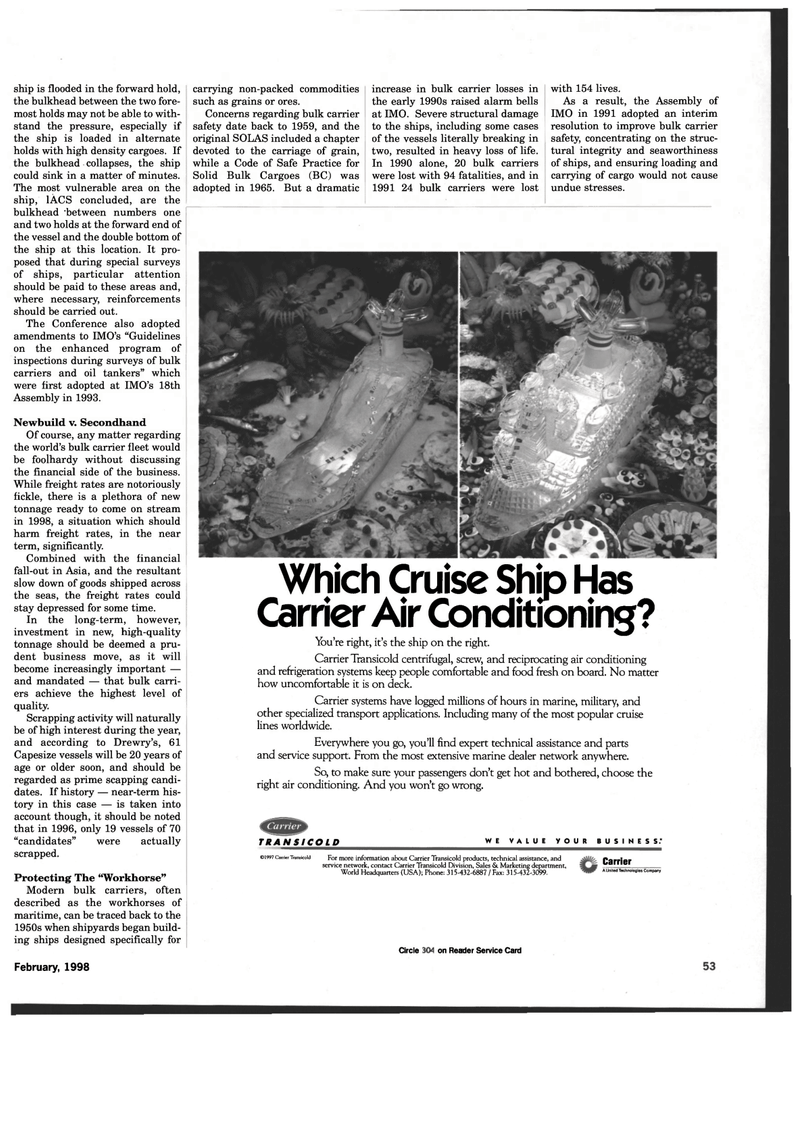
Page 57: of Maritime Reporter Magazine (February 1998)
Read this page in Pdf, Flash or Html5 edition of February 1998 Maritime Reporter Magazine
ship is flooded in the forward hold, the bulkhead between the two fore- most holds may not be able to with- stand the pressure, especially if the ship is loaded in alternate holds with high density cargoes. If the bulkhead collapses, the ship could sink in a matter of minutes.
The most vulnerable area on the ship, lACS concluded, are the bulkhead "between numbers one and two holds at the forward end of the vessel and the double bottom of the ship at this location. It pro- posed that during special surveys of ships, particular attention should be paid to these areas and, where necessary, reinforcements should be carried out.
The Conference also adopted amendments to IMO's "Guidelines on the enhanced program of inspections during surveys of bulk carriers and oil tankers" which were first adopted at IMO's 18th
Assembly in 1993.
Newbuild v. Secondhand
Of course, any matter regarding the world's bulk carrier fleet would be foolhardy without discussing the financial side of the business.
While freight rates are notoriously fickle, there is a plethora of new tonnage ready to come on stream in 1998, a situation which should harm freight rates, in the near term, significantly.
Combined with the financial fall-out in Asia, and the resultant slow down of goods shipped across the seas, the freight rates could stay depressed for some time.
In the long-term, however, investment in new, high-quality tonnage should be deemed a pru- dent business move, as it will become increasingly important — and mandated — that bulk carri- ers achieve the highest level of quality.
Scrapping activity will naturally be of high interest during the year, and according to Drewry's, 61
Capesize vessels will be 20 years of age or older soon, and should be regarded as prime scapping candi- dates. If history — near-term his- tory in this case — is taken into account though, it should be noted that in 1996, only 19 vessels of 70 "candidates" were actually scrapped.
Protecting The "Workhorse"
Modern bulk carriers, often described as the workhorses of maritime, can be traced back to the 1950s when shipyards began build- ing ships designed specifically for carrying non-packed commodities such as grains or ores.
Concerns regarding bulk carrier safety date back to 1959, and the original SOLAS included a chapter devoted to the carriage of grain, while a Code of Safe Practice for
Solid Bulk Cargoes (BC) was adopted in 1965. But a dramatic increase in bulk carrier losses in the early 1990s raised alarm bells at IMO. Severe structural damage to the ships, including some cases of the vessels literally breaking in two, resulted in heavy loss of life.
In 1990 alone, 20 bulk carriers were lost with 94 fatalities, and in 1991 24 bulk carriers were lost with 154 lives.
As a result, the Assembly of
IMO in 1991 adopted an interim resolution to improve bulk carrier safety, concentrating on the struc- tural integrity and seaworthiness of ships, and ensuring loading and carrying of cargo would not cause undue stresses.
Which Cruise Ship Has Carrier Air Conditioning?
You're right, it's the ship on the right.
Carrier Transicold centrifugal, screw, and reciprocating air conditioning and refrigeration systems keep people comfortable and food fresh on board. No matter how uncomfortable it is on deck.
Carrier systems have logged millions of hours in marine, military, and other specialized transport applications. Including many of the most popular cruise lines worldwide.
Everywhere you go, you'll find expert technical assistance and parts and service support. From the most extensive marine dealer network anywhere.
So, to make sure your passengers don't get hot and bothered, choose the right air conditioning. And you won't go wrong.
TRANSICOLD WE VALUE YOUR BUSINESS." ©1997 Carrier Transicold For more information about Carrier Transicold products, technical assistance, and service network, contact Carrier Transicold Division, Sales St Marketing department,
World Headquarters (USA); Phone: 315-432-6887 / Fax: 315-432-3099.
Carrier
A United Technologies Company
Circle 219 on Reader Service Card
February, 1998 40-A

 56
56

 58
58
